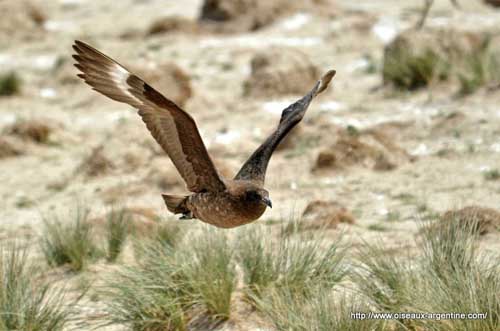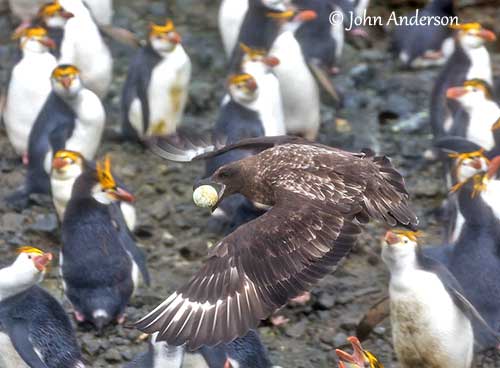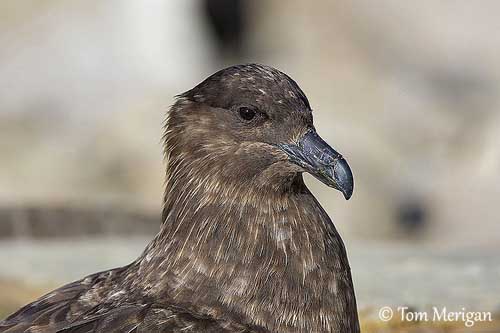
Fr: Labbe antarctique
All : Antarktis Skua
Esp : Págalo Subantártico
Esp (Argentine): Escúa polar
Ital : Stercorario antartico
Nd: Subantarctische Grote Jager
Sd: Antarktislabb
Port: Mandrião-antártico
Photographers:
John Anderson
John Anderson Photo Galleries
Tom Merigan
Tom Merigan’s Photo Galleries
Philippe and Aline Wolfer
OISEAUX D'ARGENTINE
Text by Nicole Bouglouan
Sources:
HANDBOOK OF THE BIRDS OF THE WORLD Vol 3 by Josep del Hoyo-Andrew Elliott-Jordi Sargatal - Lynx Edicions - ISBN : 8487334202
SKUAS AND JAEGERS by Klaus Malling Olsen and Hans Larsson - Pica Press Sussex,
ISBN: 1873403461
BirdLife International (BirdLife International)
New Zealand birds and birding (Narena Olliver)
SORA Searchable Ornithological Research Archive (Blair O. Wolf)
Brown Skua
Stercorarius antarcticus
Charadriiforme Order – Stercorariidae Family
BIOMETRICS:
Length: 52-64 cm
Wingspan: 125-160 cm
Weight: 1200-2100 g
DESCRIPTION:
The Brown Skua is the heaviest of the Stercorariidae family. This species is highly predatory and feeds mainly on other seabirds.
The adult has brown plumage overall, sometimes uniformly dark brown or paler brown with pale creamy flecking. The crown is darker brown.
In flight, the wings show the typical white patch at base of primary flight feathers. On the underwing, coverts are dark brown, and the white patches are always present and visible. The tail is brown too, and relatively short.
The large, stout bill is blackish with hooked tip. The eyes are dark brown. Legs and webbed feet are black.

Both adults are similar.
The juvenile is darker with more uniform plumage colour. The body is more chestnut, and the white wing patches are less conspicuous than on adults.
We can find three subspecies:
S.a. antarcticus (here described and displayed) is found on Falkland Is and SE Argentina. It winters off SE South America.
S.a. hamiltoni occurs on Tristan da Cunha and Gough Is. It winters near its breeding grounds.
This race appears uniformly dark, with less pale flecking and some rufous on body. It is larger than nominate race.
S.a. lonnbergi is found in Antarctic Peninsula and sub Antarctic islands of Atlantic, Indian and Pacific Oceans. It winters near the breeding grounds or disperse slightly from them.
This one is much larger than other races, and especially around New Zealand. It shows less pale markings than nominate, but more than “hamiltoni”.
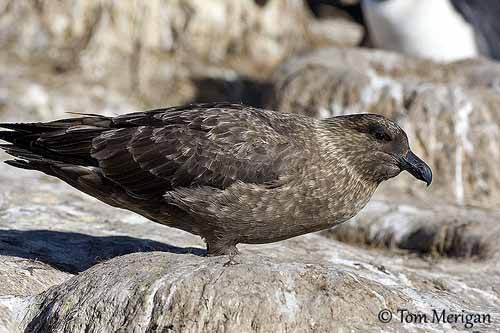
VOICE: SOUNDS BY XENO-CANTO
The Brown Skua is usually silent except in defence behaviour. Like other Stercorariidae species, the “Long-call”, a series of several “laughs”, is used as advertising call when the territory is established. This call is accompanied by the typical “Wing-raising Display”. It also gives a harsh cry while swooping at intruder.
HABITAT:
The Brown Skua is marine, but also occurs on and around islands where it can find penguins and seabirds nesting in burrows.
It breeds on islands free from human disturbance. It can be attracted to scientific bases for scavenging. Its breeding and feeding territories can be the same or are separated. The breeding grounds are on grass, moss, gravel or bare rock on offshore islets, low peninsulas or along protected coastlines.
RANGE:
See above in “subspecies”
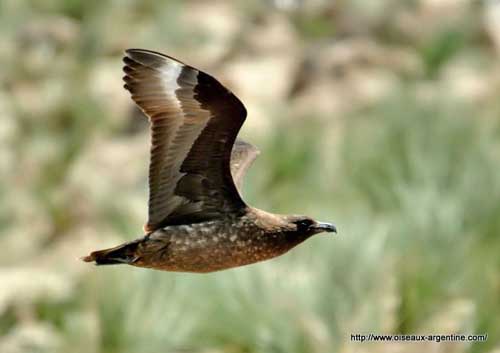
BEHAVIOUR:
The Brown Skua is a highly predatory bird, feeding mainly on seabirds nesting in burrows, penguins’ eggs, chicks and weakened adults, afterbirth and carcasses of seals.
It also scavenges near the fishing boats, and it feeds on fish at sea. But if the food resources such as seabirds are abundant, several populations are mainly resident and rarely go out to sea.
The burrow-nesting seabirds are caught on the ground while walking and at night. Introduced rabbits form part of the diet too.
During the breeding season, the Brown Skua is highly territorial and often performs the typical display with raised wings while giving its “long-call”. This display exposes the white wing patches in order to intimidate the opponent.
The Brown Skua is loosely colonial and tends to nest in communal groups consisting of a single adult female and two or more males. Polyandry is unusual among birds and only some species use this mating system. These groups appear remarkably stable during several consecutive seasons. The bonds within such groups appear as strong as between members of a pair. Some “circular-displays” are reported in the groups, as preliminary activities of pairing.
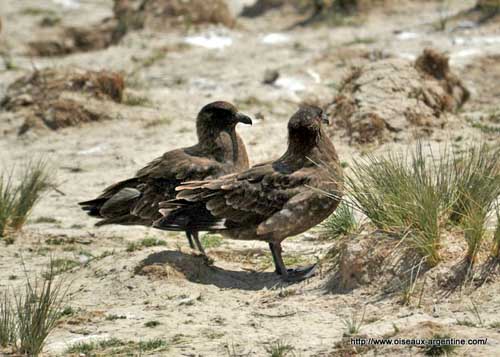
Most territories are on rocky areas on the edge of the sea, and maybe this limited breeding habitat encourages the formation of these groups. But the reasons of such communal behaviour are unknown.
The Brown Skua of colonies in New Zealand, Tristan da Cunha and Gough Is are resident throughout the year, but some of them may disperse locally to sea. In harsh habitats, all the birds leave their colonies during winter and go out to sea.
FLIGHT:
The Brown Skua has powerful flight and well developed ability to accelerate, due to the short wings allowing fast wingbeats.
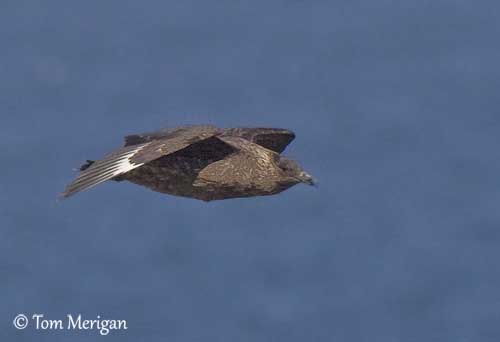
REPRODUCTION:
The breeding season occurs between September and March according to the range.
The Brown Skua breeds in loose colonies on offshore islets, along protected coasts, among short tussocks of grass and other vegetation, or among rocks, or on the ground partially covered with moss and lichens.
This species may breed in trios or small groups (see in “behaviour”)
The nest is a scrape, sometimes lined with dead grass or moss on flat area.
The female usually lays two dark olive-green eggs with blackish mottling. Incubation starts with the second egg, and lasts 28-32 days. At hatching, the chicks are covered in pale pinkish-brown down. They leave the nest 24/48 hours after birth and fledge 40-50 days later. They are sexually mature at six years old.
Except in unusually poor season, both chicks have a good chance of surviving.

DIET:
The Brown Skua is an opportunistic scavenger and predator, and feeds on wide range of preys, mainly seabirds nesting in burrows and caught at night.
It also takes eggs and chicks of penguins, including weakened adults and carcasses. Introduced rabbits on islands, fish at sea and carrion are regularly added to its diet.
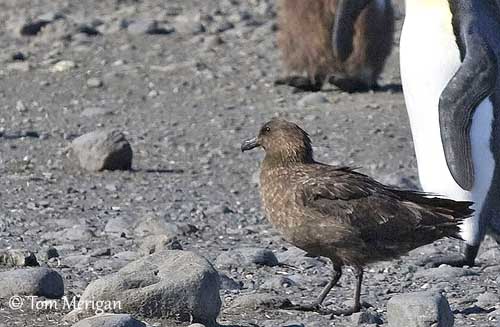
PROTECTION / THREATS / STATUS:
The Brown Skua’s numbers have been reduced by human persecution in several islands, but these birds are opportunistic and benefit from refuse and feeding opportunities at research bases. The range has expanded on Antarctic Peninsula.
In addition, these birds are long-lived and their populations appear stable. This species is not currently threatened.
